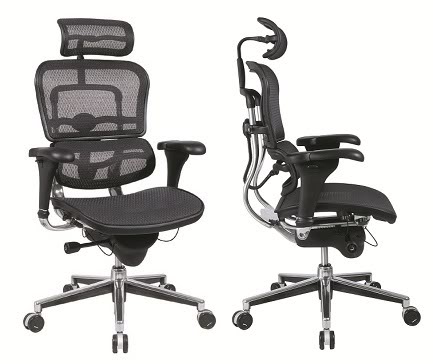Anybody who gives a damn about their own health needs to take a long, hard look at how office chairs affect their well-being. In fact, many do – growing concern about the health implications of office chairs has spurred growing sales in ergonomic chairs, exercise balls, office exercise videos, and more.
But this swelling growth industry has also created plenty of noise: bad advice about health and office chairs has mixed in with the few good nuggets, and many conscientious consumers are endangering their own health in the process.
Much of the hype has to do with unconventionally-designed office chairs – using kneeling chairs in the office, for instance, or repurposing exercise balls for use as desk chairs. This site, among others, claims that exercise balls improve spine alignment, provide room for stretching, and “burns 350 calories a day”.
Exercise Ball Reality Check
Here’s your reality check: exercise balls do not offer a significant improvement in posture when used as office chairs. As the New York Times’ Anahad O’Connor reports, “As far as posture is concerned, there is not exactly a compelling body of evidence.”
O’Connor cites a 2009 British study that found prolonged sitting on an exercise ball caused the same level of slouching and “poor sitting position” compared to regular office chairs. The study concludes: “No benefits were found through sitting on [an exercise] ball over that of [office chairs] in prolonged sitting as both seating types.”
A second study conducted by the Research Institute Move in the Netherlands “concluded that the advantages with respect to physical loading of sitting on an exercise ball may not outweigh the disadvantages.”
Kneeling Chairs: No Better?
The same thing might be said of kneeling chairs, the substitute-for-office-chairs-du-jour for a growing number of lumbar-conscious office workers.
In a study conducted for the International Journal of Industrial Ergonomics, Mats Ericson and Ian Goldie found that spinal shrinkage levels were greatest for workers using kneeling office chairs. A study for Applied Ergonomics journal concluded that as far as posture was concerned, kneeling chairs were “no better than conventional chairs and could be worse than well-designed conventional office chairs.”
The Ergonomics Report’s Jeanie Croasmun has the final word:
Just like a hammer might be a valuable tool for some tasks (hanging a picture), in others (washing dishes) it’s useless or may do more harm than good. The exercise ball might be great for strengthening and toning in the gym or at home, but it can’t compete with a truly ergonomic chair for long-term sitting in an office environment.
Workers using kneeling chairs and exercise balls as office chairs have one thing in common, says John Triano: “both of these alternatives require more active use of one’s muscles (e.g. for balance and to sit upright) than a traditional office chair.” While Triano does not discount these alternative office chairs outright, he recommends that you get a doctor’s approval before use.
Customizable ergonomic office chairs, the type recommended by the National Institutes of Health, remain your best healthy-back bet. The NIH offers six properties to look for in an ergonomic chair – while these may be pricier than exercise balls or regular office chairs, the savings you’ll get from not seeing your back doctor on an ongoing basis definitely offsets the cost.



